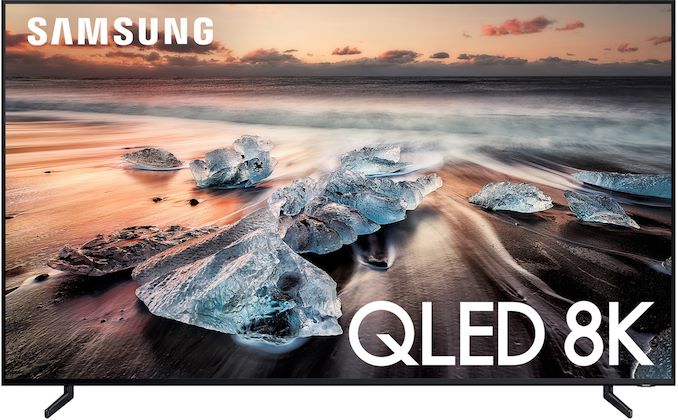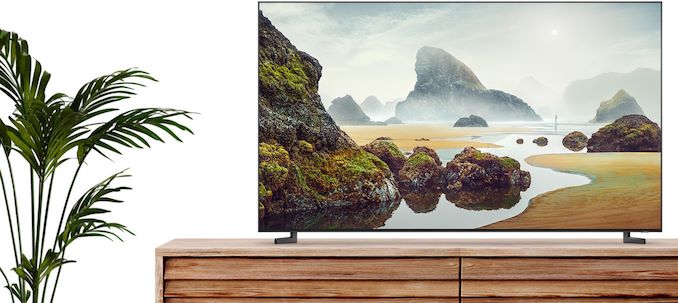Samsung Begins Sales of 65-Inch Q900R 8K UHDTV in the UK
by Anton Shilov on October 17, 2018 12:30 PM EST
Samsung on Wednesday started sales of its Q900R QLED 8K Ultra-HD televisions in the UK. The device initially available in the UK is the smaller 65-inch model, rather than the 75-inch one Samsung will be selling in the US in the coming weeks.
Samsung’s Q900R-series televisions, featuring a 7680×4320 resolution, are currently available exclusively from Currys. Right now, only 65-inch 8K UHDTV from Samsung is available, but 75-inch and 85-inch models can be pre-ordered and delivered within 10 to 21 days. The “smaller” version of Q900R is priced at £4,999 ($5,588), whereas the 75-inch will cost £6,999 ($7,825) and the 85-inch will cost £14,999 ($16,768).
Besides the 8K resolution, all Samsung’s Q900-series TVs are backed by a quantum dot-enhanced LED backlight that is also capable of FALD-like operation. The TVs offer a peak brightness of 4000 nits, which is the maximum brightness at which HDR content is mastered today. They also support HDR10, HDR10+, and HLG formats, but not Dolby Vision (at least for now). As for color gamut, the Q900-series can reproduce 100% of the DCI-P3 space.
To properly playback existing content, Samsung’s Q900-series televisions feature proprietary 8K AI Upscaling technology, which is designed to enhance the quality of digital content to panel’s native resolution (does not work with PCs, games, analogue content, etc.). Also, the Tvs are able to interpolate content to 240 FPS. Both capabilities are enabled by the company’s Quantum Processor 8K, which is responsible for all decoding, upscaling, and other operations.
Samsung is not the first company to start sales of 8K UHDTV globally, however this is a first for the UK. Sharp has been selling its 8K televisions in various regions for a little less than a year now. In the meantime, Samsung is the first to market with an 8K TV featuring a 4000 nits peak brightness.
Related Reading:
- Samsung Starts to Take Pre-Orders on 85-Inch Q900 8K UHDTV
- Samsung’s One Invisible Connection: 75 Gbps and 230W in a Ultra Thin Cable
- Sharp’s 8K UHD TV Available in Japan, Listed in Europe for €11,899
- Sharp Announces 2nd Gen 8K UHD TVs at IFA
- AUO to Ship 8K UHD TV Panels in Coming Months
- Philips Demos 328P8K: 8K UHD LCD with Webcam, Docking, Coming in 2018
- Dell’s 32-inch 8K UP3218K Display Now For Sale: Check Your Wallet











13 Comments
View All Comments
Supacon_Fizzix - Wednesday, October 17, 2018 - link
How exactly do you connect an 8K panel to something and get full resolution? Surely HDMI doesn't support that - maybe not even at 30 Hz. I think DisplayPort 1.4 can at 60 Hz. It would be weird (but not unwelcome) for a TV to have DP inputs.zmeul - Wednesday, October 17, 2018 - link
what's the point of this!? is like selling submarines to HungaryCaedenV - Wednesday, October 17, 2018 - link
First gen 4k displays had a similar issue. They rely on lower rez content and upscaling to work because there is no practical way to get all those bits in there at launch.2020 8k displays will have better support, and some content to go with it... except that there really is no content. 4k was specked out as being 'film equivalent' for archival purposes; that isn't to say that there is not some improvement going above 4k for old films... but the use case is surely limited.
I think the real reason for 8k is not for native content, but to provide a crisper picture on truly large displays. I mean really large 120"+ displays. Full wall displays, signage, etc. I could see airports replacing their 20+ display walls with 4 or 6 8k displays and seeing some power and maintenance savings.
Plus for weirdos like me who use TVs as computer monitors. You will never see the difference between 4k and 8k video footage... But static text on a 40-50" 'computer monitor' would be waaaaaay easier on the eyes in 8k. We will finally have that paper-like clarity on the desktop that we have enjoyed for years on cell phones, and that will be a welcome change! But oh man... apps that don't support scaling will need a magnifying glass lol
r3loaded - Wednesday, October 17, 2018 - link
The article doesn't mention which HDMI standard the TVs are using, but I'll assume it's HDMI 2.0 and not 2.1. The only way to get an 8K signal to the TV with HDMI 2.0 will be using 4:2:0 chroma sub-sampling and a refresh rate of 30Hz, significantly impacting the quality of the picture.Like zmeul said, it really is like selling submarines to Hungary. HDMI 2.1 should be the minimum prerequisite before even contemplating an 8K TV.
WinterCharm - Wednesday, October 17, 2018 - link
I'd be okay with the world switching to DisplayPort. It's a much better standard than HDMI anyways.euler007 - Tuesday, October 23, 2018 - link
Don't hold your breath, next up is HDMI 2.1. You can joing a BetaMax support group for your displayport concerns.enoch861 - Wednesday, October 17, 2018 - link
I don't know how many people will get it for 8k. I see people getting it more for the HDR peak brightness of 4000* nits than resolution alone. Resolution is just icing on the cake.*I'm not aware of any other TV sets that offer that caliber of brightness.
cheinonen - Thursday, October 18, 2018 - link
HDMI 2.1 supports 8K resolutions and Samsung has said that while the HDMI 2.1 spec isn't final yet, once it is, they expect to say that this TV will support it. Currently, you would be limited to USB or to streaming for 8K.demu67 - Wednesday, October 17, 2018 - link
This TV uses 4 HDMI 2.0 connectors to deliver 8K@60Hz. These HDMI connectors are connected to Q900-series One Connect Box, which is the connected to the TV using a proprietary optical connector/optical cable (One Invisible Connection).In the future, we might see a HDMI 2.1 version of the One Connect Box.
CU - Wednesday, October 17, 2018 - link
8K is only 30hz over HDMI based on the manual.HDMI (720p)
HDMI (1080i, 1080p)
HDMI (3840 x 2160p)
HDMI (4096 x 2160p)
*HDMI (7680 x 4320p @ 30 Hz)
USB (720p)
USB (1080i/p @ 60 Hz)
USB (3840 x 2160p @ 24/30 Hz)
USB (3840 x 2160p @ 60 Hz)
USB (4096 x 2160p @ 24/30/60 Hz)
*USB (7680 x 4320p @ 24/30/60 Hz)
" *: This input signal is only supported by Q900R model series.
The HDMI 1 port connection supports 8K resolution only when HDMI UHD Color is set to On, and supports 4:2:0 8-bit
30 Hz input signals only